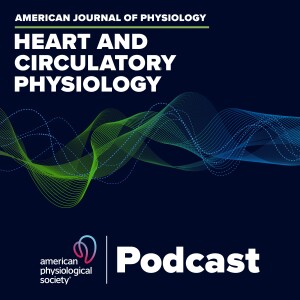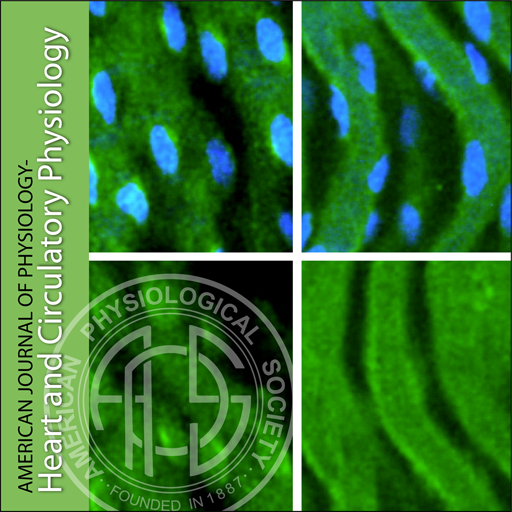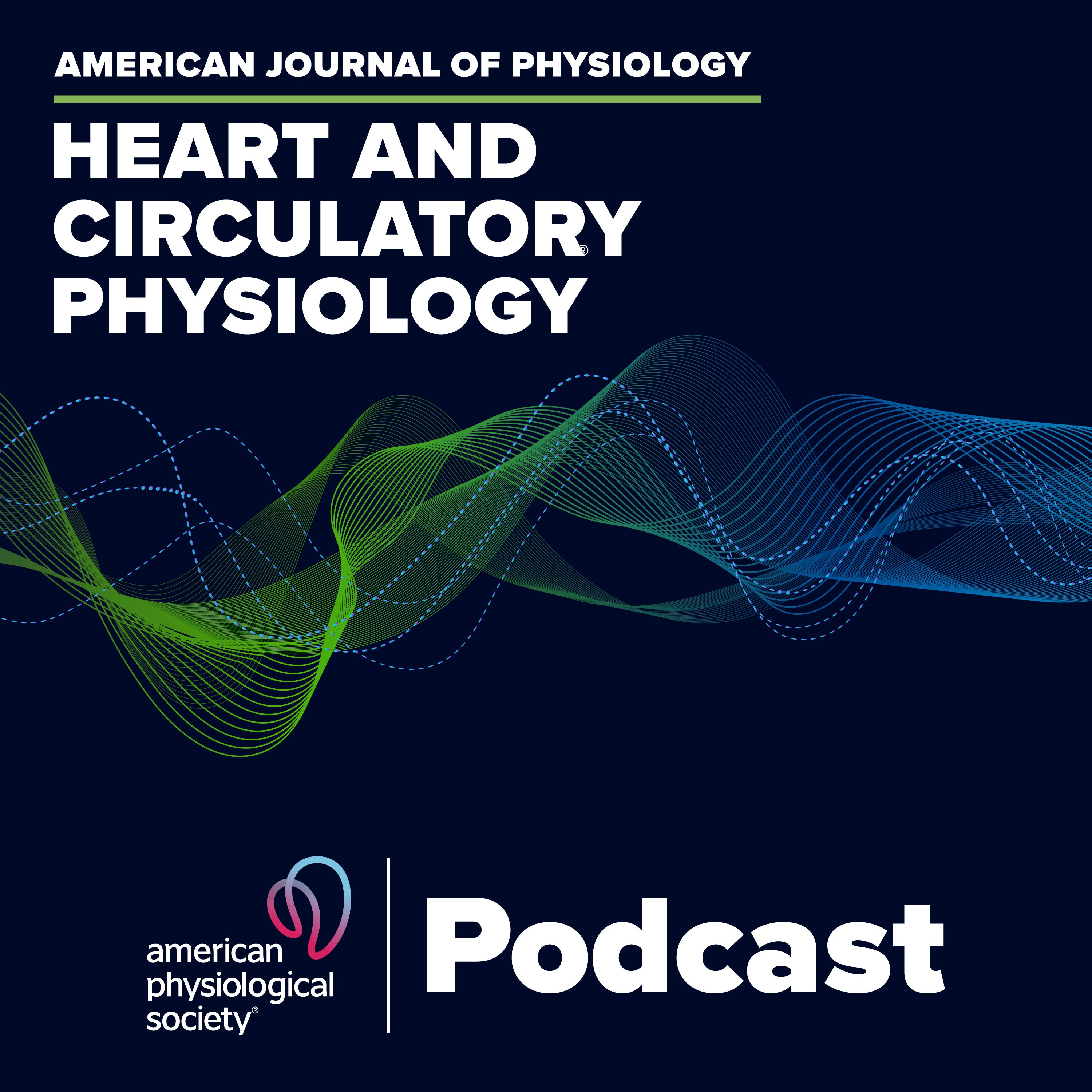Episodes

Thursday Jan 22, 2015
Diet, Sex and Exercise in Mice
Thursday Jan 22, 2015
Thursday Jan 22, 2015
Do you need to change your New Year’s dieting resolution? Maybe…according to a new study by Konhilas et al, who looked at the trifecta of soy-based versus casein-based diets, exercise, and sex differences in mice. In this engaging new podcast, Deputy Editor Merry L. Lindsey (University of Mississippi Medical Center) interviews lead author John Konhilas (University of Arizona) and expert Ganesh Halade (University of Alabama at Birmingham) about the complex work by Konhilas and colleagues which layered sex dimorphisms in exercise ability, over adaptation to disease and different elements of diet. Did the authors' waterfall of experiments show that diet and sex interact in an overall response to exercise? Listen now.
John P. Konhilas, Hao Chen, Elizabeth D. Luczak, Laurel A. McKee, Jessica Regan, Peter A. Watson, Brian L. Stauffer, Zain I. Khalpey, Timothy A. McKinsey, Todd R. Horn, Bonnie LaFleur, Leslie A. Leinwand Diet and sex modify exercise and cardiac adaptation in the mouse Am J Physiol Heart Circ Physiol, published January 15, 2015. DOI: 10.1152/ajpheart.00532.2014.

Friday Jan 09, 2015
Metabolic Syndrome and Microvessel Density
Friday Jan 09, 2015
Friday Jan 09, 2015
What is causing vascular rarefaction in the skeletal muscle of patients with metabolic syndrome? In this podcast Associate Editor Gary Lopaschuk (University of Alberta) interviews lead author Jeff Frisbee (West Virginia University) and expert Victor Samokhvalov (University of Alberta) about the work by Frisbee and colleagues, which found that the chronic reduction in vascular nitric oxide bioavailability accompanying metabolic syndrome did not match the development of the rarefaction in skeletal muscle microcirculation. Using a multivariate discriminant model and leaning heavily on the concept of temporal resolution, the authors show that thromboxane and the inflammatory pathway may be the key mechanism for the initial pulse of vascular rarefaction. What potential therapeutic pathways does this open up? Listen now.
Jefferson C. Frisbee, Adam G. Goodwill, Stephanie J. Frisbee, Joshua T. Butcher, Robert W. Brock, I. Mark Olfert, Evan R. DeVallance, Paul D. Chantler Distinct temporal phases of microvascular rarefaction in skeletal muscle of obese Zucker rats Am J Physiol Heart Circ Physiol, published December 15, 2014. DOI: 10.1152/ajpheart.00605.2014.

Tuesday Dec 16, 2014
Increased Intraluminal Pressure Changes Mechanism of Flow-Mediated Dilation
Tuesday Dec 16, 2014
Tuesday Dec 16, 2014
Why are the endothelial-derived contributors to flow-mediated dilation important to humans with vascular disease? Listen as Associate Editor Debra Diz (Wake Forest School of Medicine) interviews lead author Andreas Beyer (Medical College of Wisconsin) and expert Jennifer Pollock (University of Alabama at Birmingham) about the innovative new work by Beyer et al, which shows that an acute stress response in the human vasculature changes the mechanism of dilation from cardioprotective nitric oxide to pro-atherosclerotic hydrogen peroxide after exposure to increased intraluminal pressure. What do the authors speculate is mediating the “switch” from NO to H2O2, and how do pre-existing conditions, such as systemic hypertension, complicate the stress response mechanism? Listen to find out.
Andreas M. Beyer, Matthew J. Durand, Joseph Hockenberry, T. Clark Gamblin, Shane A. Phillips, David D. Gutterman An acute rise in intraluminal pressure shifts the mediator of flow-mediated dilation from nitric oxide to hydrogen peroxide in human arterioles Am J Physiol Heart Circ Physiol, published December 1, 2014. DOI: 10.1152/ajpheart.00557.2014.

Monday Dec 15, 2014
Circulating FGF23 Levels in Heart Failure
Monday Dec 15, 2014
Monday Dec 15, 2014
Have Imazu et al discovered a new clinical biomarker for predicting renal dysfunction in heart failure patients? In this engaging podcast Associate Editor Leon De Windt interviews lead author Masafumi Kitakaze (National Cerebral and Cardiovascular Center, Japan) and expert Thomas Thum (Hannover Medical School, Germany) about the pioneering work by Kitakaze and colleagues, which investigated the correlation between circulating FGF23 in non-ischemic patients with early chronic kidney disease and higher incidences of heart failure hospitalization in these patients. How did inflammation, ischemic conditions, gender, age, and other medications influence circulating FGF23 levels? Listen now.
Miki Imazu, Hiroyuki Takahama, Hiroshi Asanuma, Akira Funada, Yasuo Sugano, Takahiro Ohara, Takuya Hasegawa, Masanori Asakura, Hideaki Kanzaki, Toshihisa Anzai, Masafumi Kitakaze Pathophysiological Impact of Serum Fibroblast Growth Factor 23 in Patients with Non-ischemic Cardiac Disease and Early Chronic Kidney Disease Am J Physiol Heart Circ Physiol, published November 15, 2014. DOI: 10.1152/ajpheart.00331.2014.

Thursday Dec 11, 2014
Exercise Training Improves Metabo and Mechanoreflex Control in Heart Failure
Thursday Dec 11, 2014
Thursday Dec 11, 2014
The so called “exercise pressor reflex” is enhanced in chronic heart failure and drives sympathetic nerve activity during exercise. While exercise training can impact the sensitivity of this reflex, the molecular mechanisms that are at play remain unclear. Listen as Editor-in-Chief Irving H. Zucker interviews lead author Carlos Negrao (University of Sao Paulo) and expert Vaughan Macefield (University of Western Sydney) about the exciting new work by Antunes-Correa et al., who found that exercise training in chronic heart failure patients decreased the muscle mechanoreflex control of sympathetic nerve activity. Did Negrao and colleagues find that molecular abnormalities in skeletal muscle underlie abnormal muscle sympathetic nerve activity in humans with heart failure? Are these effects reversible with exercise training? Listen and learn more.
Ligia M. Antunes-Correa, Thais S. Nobre, Raphaela V. Groehs, Maria-Janieire N.N. Alves, Tiago Fernandes, Gisele K. Couto, Maria Urbana P.B. Rondon, Patricia Alves de Oliveira, Marta Lima, Wilson Mathias Jr., Patricia C. Brum, Charles Mady, Dirceu R. Almeida, Luciana Venturini Rossoni, Edilamar Menezes de Oliveira, Holly R. Middlekauff, Carlos Eduardo Negrao Molecular Basis for the Improvement in Muscle Metaboreflex and Mechanoreflex Control in Exercise-Trained Humans with Chronic Heart Failure Am J Physiol Heart Circ Physiol, published December 1, 2014. DOI: 10.1152/ajpheart.00136.2014.

Tuesday Nov 11, 2014
Mitochondrial Depolarization and Electrophysiology
Tuesday Nov 11, 2014
Tuesday Nov 11, 2014
What is the relationship between cardiac mitochondrial metabolism and the mitochondrial membrane potential? Listen as Associate Editor Gary Lopaschuk interviews lead author Matthew Sulkin (Washington University), and expert Elaine Wan (Columbia University) about the innovative work by Sulkin and colleagues combining two different optical mapping techniques. What did the authors discover when they looked directly at the mitochondrial membrane potential during ischemia-reperfusion, and how might this inform potential therapies for ventricular arrhythmias? Listen and learn more…
Matthew S. Sulkin, Bas J. Boukens, Megan Tetlow, Sarah R. Gutbrod, Fu Siong Ng, Igor R. Efimov Mitochondrial depolarization and electrophysiological changes during ischemia in the rabbit and human heart Am J Physiol Heart Circ Physiol, published October 15, 2014.
DOI: 10.1152/ajpheart.00437.2014.

Thursday Oct 30, 2014
Angiogenic Response to Exercise and Resveratrol
Thursday Oct 30, 2014
Thursday Oct 30, 2014
Can the polyphenol antioxidant resveratrol, commonly found in red wine, augment the angiogenic effects of exercise training? Guest Editor Nisha Charkoudian (U.S. Army Research Institute of Environmental Medicine) interviews lead author Lasse Gliemann (University of Copenhagen) and expert Michael Joyner (Mayo Clinic) about the fascinating, and somewhat surprising, work by Gliemann and colleagues combining exercise training in older men with resveratrol supplementation in pill form. With so much media hype focused on the possibility of a so-called "exercise pill," we break down the myths and focus on the facts in this engaging podcast. Brush off your bicycle helmet, and listen now.
Lasse Gliemann, Jesper Olesen, Rasmus Sjørup Biensø, Jakob Friis Schmidt, Thorbjorn Akerstrom, Michael Nyberg, Anna Lindqvist, Jens Bangsbo, Ylva Hellsten Resveratrol modulates the angiogenic response to exercise training in skeletal muscles of aged men Am J Physiol Heart Circ Physiol, published October 15, 2014. DOI: 10.1152/ajpheart.00168.2014.

Thursday Oct 23, 2014
Dantrolene suppresses Ca2+ sparks and Ca2+ waves
Thursday Oct 23, 2014
Thursday Oct 23, 2014
In this podcast we highlight the recent study by Domeier and colleagues, which looked for a way to pharmacologically restore proper function of the ryanodine receptor with advancing age. Did they find it? Editor in Chief Dr. Irving Zucker interviews lead author Timothy Domeier (The University of Missouri School of Medicine) and expert Eric Sobie (Mount Sinai School of Medicine) about this fascinating study investigating whether ryanodine receptor mediated calcium release in the aged heart was altered by dantrolene. In fact, Domeier and colleagues did find that dantrolene provided a protective effect against pro-arrhythmic calcium sparks and calcium waves in diastole. Hear about this finding and much more by clicking play below.
Timothy L. Domeier, Cale J. Roberts, Anne K. Gibson, Laurin M. Hanft, Kerry S. McDonald, Steven S. Segal Dantrolene suppresses spontaneous Ca2+ release without altering excitation-contraction coupling in cardiomyocytes of aged mice Am J Physiol Heart Circ Physiol, published September 15, 2014. DOI: 10.1152/ajpheart.00287.2014.
![Noninvasive Longitudinal Measurements of [Ca2+] in Arterioles of Hypertensive Optical Biosensor Mice](https://pbcdn1.podbean.com/imglogo/ep-logo/pbblog363190/July2012covergraphicforAndroidapp.png)
Friday Oct 10, 2014
Friday Oct 10, 2014
Have noninvasive calcium signaling measurement methods turned a new corner? Yes, according to a unique new study by Mauban et al. Associate Editor Nancy Kanagy interviews senior author W. Gil Wier (University of Maryland School of Medicine) and leading expert Mark Nelson (University of Vermont) about the work by Wier and colleagues, which measured intracellular levels of calcium noninvasively in the same animal over a period of several weeks. How? Wier and co-authors ingeniously immobilized the mouse ear, enabling the use of a FRET-based ratiometric calculation of actual intracellular calcium levels in vascular cells inside the living animal. Does this innovative methodology launch new possibilities for evaluating calcium signaling changes during disease development? Listen and find out.
Joseph R. H. Mauban, Seth T. Fairfax, Mark A. Rizzo, Jin Zhang, Withrow Gil Wier A method for noninvasive longitudinal measurements of [Ca2+] in arterioles of hypertensive optical biosensor mice Am J Physiol Heart Circ Physiol, published July 15, 2014. DOI: 10.1152/ajpheart.00182.2014.

Monday Sep 15, 2014
DDR2 Deletion in the Heart
Monday Sep 15, 2014
Monday Sep 15, 2014
What happens to the left ventricle and cardiac fibroblasts when DDR2 (Discoidin Domain Receptor 2) is deleted? Deputy Editor Merry Lindsey interviews lead author Randy Cowling (University of California San Diego) and expert Angelo Calderone (Montreal Heart Institute/Universite de Montreal) about the novel work by Cowling and colleagues, which explored the surprising finding that DDR2 deletion resulted in less densely packed collagen that altered myocyte contractility. Does this work provide a stepping stone to deeper investigation of the intricacies of collagen deposition by cardiac fibroblasts? Given the “plasticity” of fibroblast phenotypes, what are the implications of pathological stimuli— for example, post-myocardial infarction? Listen and learn more.
Randy T Cowling, Seon Ju Yeo, In Jai Kim, Joong Il Park, Yusu Gu, Nancy D. Dalton, Kirk L. Peterson, Barry H Greenberg Discoidin Domain Receptor 2 (DDR2) Germline Gene Deletion Leads to Altered Heart Structure and Function in the Mouse Am J Physiol Heart Circ Physiol, published online July 3, 2014. DOI: 10.1152/ajpheart.00142.2014.

